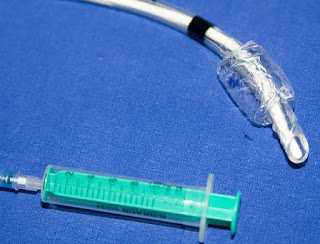 |
| Photo Credit: Borls Ott – Flickr |
 |
| This post was peer reviewed. Click to learn more. |
Author: Andrew V. Bokarius, MD
Emergency Medicine Resident
University of Chicago
There are a number of issues that may come up prior to, during, and after successful intubation. Let’s take a look at a few common problems and possible solutions.
Pre-intubation:
- Can’t mask ventilate:
- Turn head to the side, consider oral/nasal airway or LMA.2
- Can’t intubate, patient has a Grade 4/Mallampati Class 4 view:
- Can’t ventilate, can’t intubate:
- Not always the time to go directly to the cric kit, but certainly keep it in your back pocket. You may try an LMA first and adjust the patient’s position. If the patient has received RSI meds and now is waking up, have the meds wear off and allow the patient to breathe. Of course, if nothing improves the situation and saturations continue to drop, cricothyroidotomy should be considered next.[3]
Post-intubation:
- Saturation drops after intubation:
- First, confirm placement of the ETT with end-tidal CO2; do not rely solely on colorimetry – can be unreliable depending on gastric contents, i.e., carbonated beverages can give false positive readings by releasing CO2.[4]
- Give 100% FiO2, switch to ambu-bag to see what the lung compliance is like.
- Listen to the lung sounds: is there bronchospasm? Perhaps the tube is in the right mainstem.
- Consider bronchodilators depending on what you hear and consider suctioning the tube.[4] Note that with bronchospasm if inspiratory pressures are high you may have the ETT too far, i.e., at the carina. In that case, again, hand-ventilate, listen, and adjust tube position.
- Common ET Tube problems include: kinked tube, esophageal intubation, right mainstem intubation, cuff tear, and emesis blocking the tube after aspiration event, in which case you may have to replace the tube.[5]
- If the patient is “bucking the vent,” i.e., developing respiratory distress after intubation, hand-ventilate to check compliance and increase the analgesic/sedative dosage.
Pearls to correct vital signs abnormalities post-intubation:
- Hypertension: if pressure was normal before intubation, hypertension is usually due to light sedation; increase the anesthetic dosage.
- Hypertension and tachycardia: most likely due to light anesthesia; increase the sedative and/or analgesic dosage.
- Hypertension and bradycardia: think Cushings if neuro case; raise head of bed, temporary hyperventilation to reduce ICP, obtain a neurology/neurosurgery consult.
- Hypotension: may be an issue with high PEEP and low preload; consider reducing PEEP and giving fluid boluses; commonly, may need to lighten the anesthetic. If these interventions fail to resolve low BP, think of adding an inotrope.
- Hypotension and bradycardia: likely a vagal response; check eye/larynx, use glycopyrrolate and/or atropine to reverse.
- Hypotension and tachycardia: many reasons, but commonly think of hypovolemia, tension pneumothorax, or sepsis; consider IVF/pressors/needle decompression.
References:
- Mallampati SR, Gatt SP, Gugino LD, et al. A clinical sign to predict difficult tracheal intubation; a prospective study. Can Anaesth Soc J. 1985;32(4):429–434. doi:10.1007/BF03011357. PMID: 4027773
- Pollack C V. The laryngeal mask airway: a comprehensive review for the Emergency Physician. J Emerg Med. 2001;20(1):53–66. PMID: 11165839
- Niven AS, Doerschug KC. Techniques for the difficult airway. Curr Opin Crit Care. 2013;19(1):9–15. doi:10.1097/MCC.0b013e32835c6014. PMID: 23242213
- Leong MT, Ghebrial J, Sturmann K, Hsu CK. The effect of vinegar on colorimetric end-tidal carbon dioxide determination after esophageal intubation. J Emerg Med. 2005;28(1):5–11. doi:10.1016/j.jemermed.2004.06.012. PMID: 15656997
- Apfelbaum JL, Hagberg CA, Caplan RA, et al. Practice guidelines for management of the difficult airway: an updated report by the American Society of Anesthesiologists Task Force on Management of the Difficult Airway. Anesthesiology. 2013;118(2):251–70. doi:10.1097/ALN.0b013e31827773b2. PMID: 23364566
